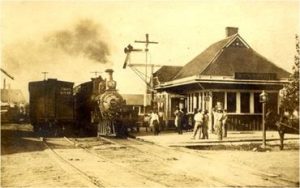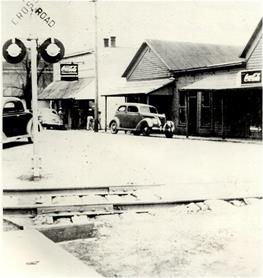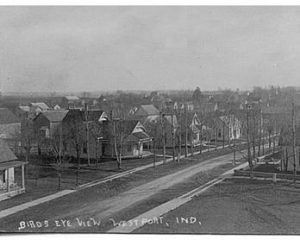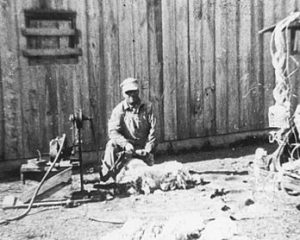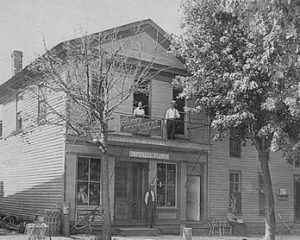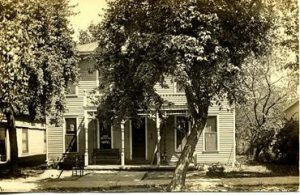History of Westport
1836 - Founding of Westport
Westport, Indiana Historical Timeline
- March 23: Hockersmith Merryman and Simeon Sharp formally establish the town of Westport by laying out a small plat of just 20 lots. While the official town is small, much of Decatur County’s land has already been purchased, indicating early settlement interest.
- Early Structures and Businesses: Westport’s first structures include three log huts, and William Shultz opens a modest store, later sold to Richard Belt. Initial frame buildings appear, with Shultz establishing a grocery, Noah Merryman opening a whiskey shop, and John Cann founding a dry goods store, forming the initial town center.
1840 - Growth of Small Trades and Medical Services
Growth of Small Trades and Medical Services
- Lewis C. Stott arrives, observing just three householders and one storekeeper in town. He establishes a tanyard north of Westport.
- Dr. John Conwell also settles in Westport, launching a medical practice. Shortly after, he returns to Ireland to marry Mary and brings her back to start their family in Westport. Conwell’s medical practice serves as one of the earliest healthcare services in the area.
1850-1855 Trade Expansion
Trade Expansion
- Westport begins to diversify with a range of trades. James Vandever and Ples Griffy open a tin shop, quickly gaining popularity, while L.D. Underwood establishes a cabinet-making business.
- Dr. William M. McCullough opens Westport’s first drug store and later expands into dry goods. He eventually sells his dry goods business to John Cann, who successfully runs it for years. With these additions, Westport starts to emerge as a small trade hub.
1861-1865 - Civil War
Civil War Period and Local Impact
Westport sees a reduction in population as men leave for military service. Main Street becomes the center of activity with churches and schools.
August 13, 1872 - Devastating Fire
Devastating Fire on Main Street
- A significant fire engulfs several buildings on the north side of Main Street, destroying key businesses, including DeArmond Brothers’ Hotel, Robert Armstrong’s dry goods store, William T. Stott’s drug store, the Masonic Lodge, and several general stores. Residents far north of town report fires on their roofs from burning shingles. Some businesses rebuild on Mulberry Street to allow more space between buildings, but the town’s population falls from 500 to 212 by the late 1870s.
1880 - Revival with the Railroad
Revival with the Railroad
- The construction of the V.G.&R. Railroad brings renewed life to Westport. With improved transportation and access, the town sees increased commerce, growth, and a population rebound. The thriving Westport School further attracts new families, establishing Westport as a desirable place to live.
1884-1896 - Establishment of Churches and New School
Establishment of Churches and New School
- In 1884, the Baptist community builds a new frame church, replacing the previous brick structure. This growth continues as the Methodist congregation constructs a new brick church in 1892, which remains in use today. By 1896, the town builds a new school to accommodate the growing student population, reflecting the town’s development as a family-friendly community.
1894-1901 - Commercial Building Boom
Commercial Building Boom
- The Burk Building, housing a jewelry store, is constructed in 1894 on Main Street. In 1901, the I.O.O.F. Lodge builds a new brick structure, replacing a previous family-owned frame dwelling. These additions mark the continued development of Westport’s business district.
November 13, 1911 - Second Large Fire on Main Street
Second Large Fire on Main Street
- Another major fire hits Westport, this time affecting the south side of Main Street. The fire destroys Whalen’s Hardware, the Low Hotel, and Mrs. R.L. Slater’s Millinery Store. Unlike in 1872, the presence of fire hoses helps limit the damage to surrounding buildings, though the fire still devastates the business district.
1912-1916 - Reconstruction and New Buildings
Reconstruction and New Buildings
- In the years following the fire, the K.P. Lodge builds a replacement for the Low Hotel, and the Christian congregation constructs a new brick church. The Baptist congregation also builds a new worship space in 1916. With these developments, Main Street becomes a continuous, solid front of businesses and community buildings.
1928-1930s - Great Depression and Economic Slowdown
Great Depression and Economic Slowdown
- Westport’s growth stagnates due to the economic downturn of the Great Depression. During this period, only a few buildings are added, including Bewley’s Bakery in 1927 and Narwold’s garage and restaurant.
1947-1950s - Residential and Infrastructure Expansion
Residential and Infrastructure Expansion
- Starting in 1947, Westport sees new residential developments and infrastructure improvements. The introduction of a water system in 1947 and a later sewer system encourages housing construction and attracts new businesses. This infrastructure upgrade is pivotal in positioning Westport for post-war growth.
1960s-1980s - Changes in Transportation and Economy
Changes in Transportation and Economy
- In 1937, State Highway 3 is constructed, providing Westport with better connectivity. However, the town later loses prominence due to the abandonment of nearby railroads and the construction of major highways I-65 and I-74, diverting traffic and business away from Westport. The closure of the Westport School adds further challenges, transforming Westport more into a residential community.
1984 - A Residential Community with New Opportunities
A Residential Community with New Opportunities
- By 1984, Westport is recognized as a primarily residential town, though local efforts to attract businesses continue. The Westport Area Business Association (T.I.W.A.B.A.) successfully recruits Wheaton USA to open a local facility, generating new employment opportunities and bolstering the local economy.
2021 - 185th Anniversary of Westport
185th Anniversary of Westport
- Westport celebrates its 185th anniversary, commemorating its resilience and evolution from a small plat to a community with deep historical roots and an enduring sense of identity.



